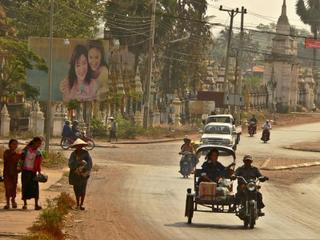 Although counting only about 30,000 inhabitants, Pakse is the most important town of South Laos. Situated at the confluence of the Xe Dong river and the Mekong, Pakse is an important traffic junction.
Although counting only about 30,000 inhabitants, Pakse is the most important town of South Laos. Situated at the confluence of the Xe Dong river and the Mekong, Pakse is an important traffic junction. From Pakse routes lead to Thailand, Vietnam and Cambodia and as a base for exploring the Bolaven Plateau and Four Thousand Islands.
To get to Pakse you have several options.
Lao Aviation flies to Pakse from Vientiane.
You can reach Pakse by boat from the north or the south, although these services change regularly.
Buses run from Vientiane daily and the journey can take as long as 15 hours. This bus service also serves the towns of Tha Kek and Savannakhet.
There is an international check point at Ban Muang Kao on the Thai border with Chong Mek. You can get a Visa on arrival at this checkpoint. After entry into Laos, a short taxi ride to the new Bridge into Pakse.
Coming from Thailand, the nearest airport, train station and bus terminus to Chong Mek is Ubon Ratchathani - about 1 hour by road from the border.
Accommodation options include Sabaidy 2 Guesthouse at about $4 or the more upmarket Seng Aroun Hotel at around $12.
A couple of the more commonly recommended eateries are Lhan Kham Restaurant (for breakfast), Mai Fai Restaurant (basic Western and Lao fare) and Riverside at the confluernce of the Mekong and Se Kong rivers for a chilled Bia Lao.
Bolaven Plateau
Situated on the north east of Champassak province, the plateau covers parts of Salavan, Attapeu and Sekong provinces although there are more options for tourists visiting the plateau in Pakse.
The plateau is fertile farmland specialising in coffee, tea, cardamom and fruit. The plateau houses a dozen mainly animist ethnic minorities, including Laven, Alak, Katou, Ta-Oy, Houne, Ngai and Suk communities. Accomodation on the plateau is limited, but Tad Lo waterfalls has a number of bungalows.
Sii Pan Don - Four Thousand Islands
The southernmost part of Champassak province, forms the border with Cambodia. Here, the Mekong river spreads to a width of up to 14km during the rainy season forming hundreds of islands and islets. The larger islands are inhabited and the largest southern island, Don Khone has an old disused 5km railway, built by the French as part of the Mekong bypass route.
The river cannot be navigated south of Don Khone because of the Khone Falls - the smaller Samphamit Falls and the larger Khong Phabeng Falls - the biggest in Asia, and maybe the widest falls in the world. Near the falls can be found the endangered Irriwaddy dolphins.

No comments:
Post a Comment